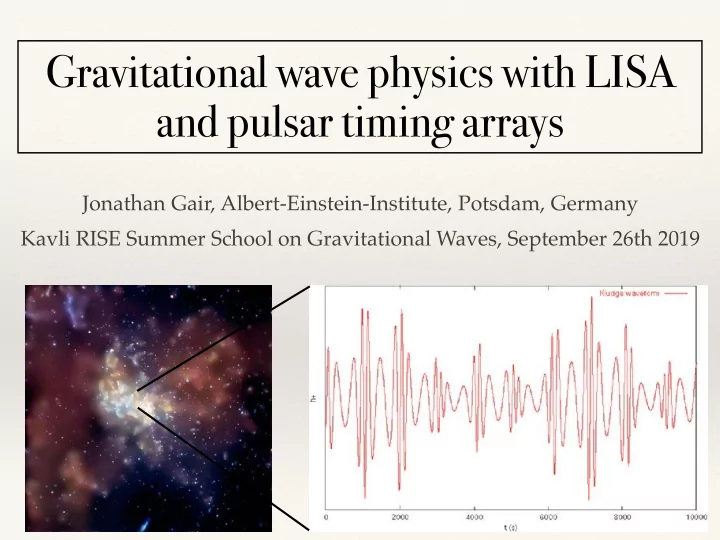

Gravitational wave physics with LISA and pulsar timing arrays Jonathan Gair, Albert-Einstein-Institute, Potsdam, Germany Kavli RISE Summer School on Gravitational Waves, September 26th 2019
Talk Outline The Laser Interferometer Space Antenna (LISA) ❖ Pulsar-timing detection of gravitational waves ❖ Sources for LISA and pulsar timing arrays (PTAs) ❖ Tests of gravitational physics with LISA observations ❖ Cosmography with LISA observations ❖ Fundamental physics with PTA observations ❖
The Laser Interferometer Space Antenna Long history. Original design (1998) ❖ - Gravitational wave detector operating in millihertz band. - Three satellites, 5 million km apart, in heliocentric, Earth- trailing orbit. 6 laser links. - Joint NASA/ESA project. - Technology demonstrator mission, LISA Pathfinder, approved. Launched 2015. NASA dropped out in 2011. New ❖ ESA-only mission eventually selected for L3 (2034).
LISA Status LISA now reinvigorated and timetable ❖ accelerated - LISA Pathfinder spectacularly demonstrated the technology. - Detection of GW150914+ renewed interest in gravitational waves. - mission now in phase A, adoption in 2022-2024; - mission launch: 2034. Mid-decadal review expressed strong ❖ support for NASA re-involvement, at probe-class level (~$400m). Design: 2.5Gm arms, 6-link geometry. ❖
Pulsar timing Pulsars are rapidly rotating Neutron ❖ Stars. Observations indicate great homogeneity in pulse profile, and little variation in frequency. Pulsars are very accurate clocks. ❖ Plots from I H Stairs (2003)
Pulsar timing arrays GW passing between source and ❖ observer induces periodic change in pulse time of arrival. Use a network (array) of pulsars to ❖ increase signal to noise.
Pulsar timing arrays There are three major pulsar timing ❖ efforts - EPTA - the European Pulsar Timing Array. Data collected from six telescopes in UK, Netherlands, France, Germany and Italy.
Pulsar timing arrays There are three major pulsar timing ❖ efforts - EPTA - the European Pulsar Timing Array. Data collected from six telescopes in UK, Netherlands, France, Germany and Italy. - NANOGrav - US/Canada PTA. Data collected using Arecibo and the Green Bank Telescope.
Pulsar timing arrays There are three major pulsar timing ❖ efforts - EPTA - the European Pulsar Timing Array. Data collected from six telescopes in UK, Netherlands, France, Germany and Italy. - NANOGrav - US/Canada PTA. Data collected using Arecibo and the Green Bank Telescope. - PPTA - the Parkes Pulsar Timing Array. Australian collaboration. The three PTAs combine data as the ❖ International Pulsar Timing Array (IPTA).
Detector sensitivities http://gwplotter.com
Gravitational wave sources for LISA
LISA sources: massive black hole mergers Expected to occur following mergers of the host galaxies. LISA can observe ❖ gravitational waves from these with very high signal-to-noise ratio.
Recommend
More recommend